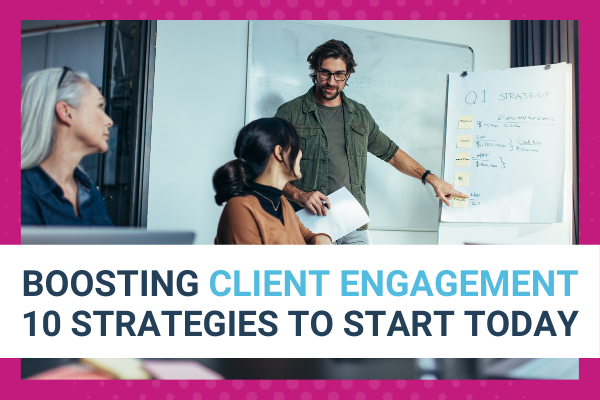Client engagement sounds like it should come naturally, but what happens when your clients don’t interact with your products, content, or tools? If you’re producing high-quality, valuable content, it’s frustrating to feel like these efforts go unnoticed. Client engagement is a big part of the overall customer experience. How do you create real results?
First, what is client engagement? This is the scope of interactions between your clients and your brand. When clients are engaged, they’re more likely to stay loyal and make repeat purchases. Reducing churn should always be a priority, so focusing on your engagement strategy is a must.
Believe it or not, your clients want to engage with your business. They want to build real connections. This is how you turn passive users into lifelong superfans. If you’ve noticed your customers are turning passive, it’s time to turn things around for good. It only takes a few key changes to optimize your interactions for the better.
The good news is it’s never too late to focus on your client engagement strategy. If you’re building a customer-first business, you can’t ignore the power of engagement. In this guide, we’ll explore 10 strategies to start today that create real, authentic connections again and again.
- Collect feedback regularly from new and old clients.
- Put feedback into action (and notify your clients).
- Tailor all communication to each client’s preferences.
- Explore your clients’ goals and challenges.
- Share content to help clients meet those goals and challenges.
- Interact with clients regularly and across a variety of channels.
- Reward existing clients for their loyalty.
- Reach out to absent or “quiet” clients.
- Involve clients in your philanthropic efforts.
- Always support existing clients as much as new ones.
- Improve Your Client Engagement for Greater Connections
Collect feedback regularly from new and old clients.
To begin, make sure you have a strategy for collecting feedback. Your client feedback is one of your biggest assets. Too many brands assume they know what clients want, but they don’t actually take it steps further to ask.
Not only does collecting feedback show that you’re listening, but it also gives you a chance to do better. Moreover, research shows that the act of just asking for feedback keeps customers from churning. In simple terms, collecting feedback shows you care.
With that in mind, how do you collect feedback? This can be in the form of surveys for existing or new customers, in-app or web-based surveys, or even as a part of support interactions. Including collecting feedback into your strategy makes you a strong, mindful brand.
Put feedback into action (and notify your clients).
Asking for feedback is the first step. Next, you have to take real action based on this feedback. Better yet, let your existing clients know that you take this feedback seriously by notifying them of your changes.
A reported 41% of customers say that when brands reply to their online reviews, they feel understood. Getting feedback doesn’t have to be complicated. As we said, it’s often as simple as just asking. In fact, 68% of consumers left a review for a local business after just being asked.
When you’ve gathered insights, share your changes. Perhaps you decide to update your checkout page, or you’re designing a new support tool. No matter what changes you make, update your clients so they feel in on the action.
One brand that took customer feedback into account to create real change is the shoe brand Adidas. After hearing from their customers about the importance of sustainability in new products, they introduced the Parley collection of footwear. This new line is created in partnership with Parley Ocean plastic, creating a sustainable option for customers.
Tailor all communication to each client’s preferences.
When communicating with clients, keep their preferences in mind. Your customers aren’t all the same, and that means you shouldn’t connect with them in the same ways. In this day and age, we have a lot of ways to communicate. If possible, tailor your communication to each client’s preferences.
While you likely won’t have the bandwidth to offer every type of communication, some popular choices include:
- Email: Email might seem old-fashioned in today’s world, but it’s still a highly effective way to engage your clients.
- Website: Most people prefer self-service through a website, online portal, or help guide compared to other types of service.
- Phone: For some customers, the tried-and-true phone call holds a special place.
- Webchat: On the other hand, not everyone likes to pick up the phone to ask questions. A chat support tool is a great way to communicate with these clients.
Consider the ways you can adapt your communication to meet your customers where they already are. Choosing one or two options that suit the majority of your clients gives them flexibility when they need to talk to you.
Explore your clients’ goals and challenges.
Next, look beyond your clients’ purchases. What are their bigger goals? What do they wish to achieve or overcome by working with you? When you dig deeper, you learn how to assist your customers on a meaningful level.
When considering goals for your clients, make sure your goals are S.M.A.R.T. This means:
- Specific: The goal is specific and describable.
- Measurable: You have a way to measure your progress.
- Attainable: Is this goal achievable and realistic?
- Relevant: What’s the significance of reaching this goal for your clients?
- Timely: Lastly, what is your timeframe for reaching this goal?
By understanding your clients’ goals, you can create products, services, and tools that go the extra mile. This goal should be at the heart of each attraction, giving you the perspective needed to go above and beyond.
Share content to help clients meet those goals and challenges.
Now that you understand your clients’ goals, you’re prepared to create content with these needs in mind. All content should be valuable and meaningful. This doesn’t mean you have to throw your existing content out the window. Instead, take stock of what you currently have. How can you adapt or repurpose existing content to be even better or beneficial?
How do you learn what content your clients’ are looking for? There are a lot of different strategies:
- Industry research: What gaps are missing in your industry? Could your clients’ benefit from statistics, research, or how-to guides?
- Competitors: Known as the skyscraper technique, can you build on what your competitors are doing and make it 10x better?
- Surveys: Again, this is a great opportunity to ask for feedback from your existing clients.
- Social listening: Tune in to social media to determine if there are any trending topics or keywords.
- Support team: Lastly, ask your sales and support team if they have any insight into your customers’ paint points.
The social media planning tool Planoly utilizes their blog and email blasts to share the latest social media marketing trends with their audience. With how-to guides offered free of cost, they position themselves as the best solution for their clients’ goals of social media success.
Interact with clients regularly and across a variety of channels.
Today, clients want to feel connected with your brand. They want to start a dialogue both with your company and each other, creating their own community. Email, social media, and chatbots aren’t just places to promote yourself. They’re where people go to socialize and share. Being a part of this is the best way to interact with clients regularly.
This doesn’t have to be complicated or time-consuming. First, create a strong social media and email strategy to make sure you’re engaging with your existing clients regularly. It’s not enough to engage with them once and then never again.
A reported 54% of social media users are actively researching brands and products. It’s your job to position yourself in these channels so your brand is seen, noticed, and trusted. Tracking your mentions, comments, replies, and messages through a social media management tool is one of the easiest ways to stay on top of your multi-channel engagement in a meaningful way.
Reward existing clients for their loyalty.
Next, make sure your existing clients know you value them. Unfortunately, too many brands focus their attention on new customers. This makes sense—they’re the ones actively engaging with the sales process. However, with 63% of a company’s business coming from existing customers, it’s worth spending extra time making sure they feel important.
It’s up to you to keep your clients coming back again and again. How do you show them they’re appreciated? There are a lot of different options:
- Discounts: When clients spend a lot, offer them a discount on future purchases or for reaching a certain threshold.
- Trials: Invite your best superfans to trial new products and services before others.
- Free items: Everyone loves free things, including your clients. Gift free items with special purchases (BOGO, free download, etc).
- Event: Host a special event for your clients, like a preview evening, launch party, or thank-you dinner.
- Referrals: Encourage referrals by offering free discounts or gifts for every new client referred to your business.
Customer loyalty is no small matter, so give it the attention it deserves. Every client wants to feel noticed, valued, and appreciated. These small actions go a long way towards encouraging repeat business and repeating churn.
Reach out to absent or “quiet” clients.
Along those lines, also make a point to reach out to absent or “quiet” clients. These silent customers are the ones who aren’t making complaints or giving feedback, but that doesn’t mean they’re completely satisfied. These clients aren’t likely to make a purchase any time soon unless you engage them in a new way.
According to recent research, only 13% of unhappy customers actually share their complaints. Of these, only 1 in 25 complain directly to you. The customers that don’t complain? They’ll likely just stop doing business with you sooner or later. Your job is to re-engage these customers before it’s too late.
How do you reach out to absent clients? You can begin by asking for feedback about their current experience and what you can do better. When in doubt, offer freebies, discounts, and coupons to re-engage their interests. In a perfect world, all customers would be enthusiastic superfans. In reality, you have to put in the work to convert passive customers to engaged customers.
Involve clients in your philanthropic efforts.
Next, it’s time to find your philanthropic passion. If you want to boost client engagement, you need a cause worth fighting for. Today, people like to support brands that do real good in the world. Not only does this make you more trustworthy, but it makes consumers more willing to support your brand.
Today, consumers are 4 to 6 times more likely to purchase and champion purpose-driven companies. Your purpose should connect with your audience. You could donate a percentage of sales to a good cause, for instance, or sponsor a community charity. There are no limits to how you include philanthropic efforts in your strategy.
The eyewear brand Warby Parker knows the power of doing good. Their Buy a Pair, Give a Pair program supports communities around the globe when it comes to eyewear accessibility. By working with partners worldwide, for each pair of Warby Parker glasses purchased, a pair is given to someone in need.
During the COVID19 crisis, they focused on distributing eyewear to healthcare workers and their families. This big initiative makes a positive impact with each purchase. More importantly, it makes the difference between a customer choosing Warber Parker over a competitor.
Always support existing clients as much as new ones.
Lastly, always support your existing clients just as much as new ones. This is a lesson we can learn from cable or internet companies. These providers notoriously entice new customers with generous “welcome” offers, only to raise prices later on. This type of bait-and-switch is never appreciated, and it sends the wrong message to your clients.
Instead, be as good to long-time customers as you are to leads you’re actively nurturing. Their loyalty is never guaranteed, and you should always remind them of why they want to choose you over the competition.
Create a long-term strategy for addressing the needs of your current customers. Update your offerings, create loyalty programs, and continue to re-engage your current clients. Remember, it’s always more valuable to nurture the customers you have than to constantly seek out new ones.
Improve Your Client Engagement for Greater Connections
Ultimately, the more people engage with your business, the better your ROI. Your marketing and sales budget can only get you so far. Make sure you’re focusing on all stages of your client journey, not just attracting new leads.
From personalization to improving the overall experience, every effort helps boost client engagement. Superfans aren’t created overnight. They come from long-term engagement at every level. When you invest in engaging with your existing clients, they continue to support your brand into the future.






